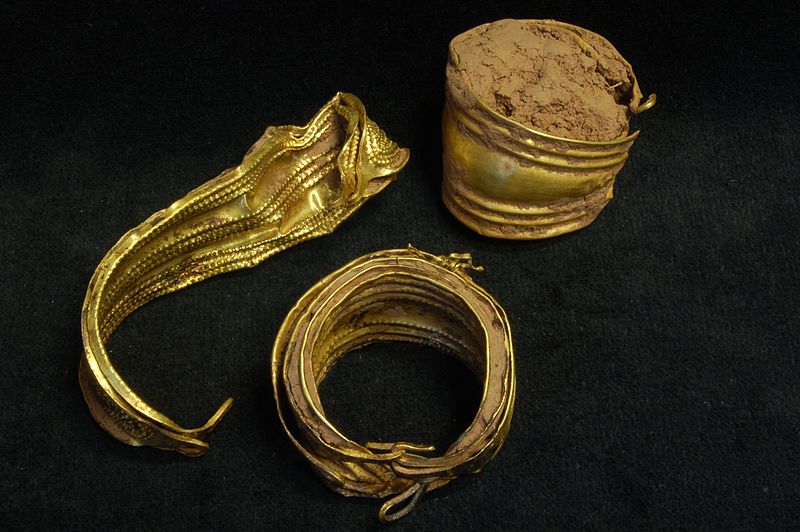 Mysteries
Mysteries  Mysteries
Mysteries  History
History 10 Surprising Stories About the Texas Rangers
 Humans
Humans 10 Philosophers Who Were Driven Mad by Their Own Theories
 Miscellaneous
Miscellaneous 10 Video-Game-Worthy Weapons and Armors from History
 Weird Stuff
Weird Stuff 10 Psychics Who Accurately Predicted Wartime Events
 The Arts
The Arts 10 Pieces of Art Inspired by a Broken Heart
 Health
Health 10 Science Fiction-Sounding New Medical Treatments
 History
History 10 Surprising Facts About the Father of Submarine Warfare
 Space
Space Ten Astonishing New Insights into Alien Worlds
 Weird Stuff
Weird Stuff 10 Bizarre Summer Solstice Rituals Still Practiced Today
 Mysteries
Mysteries Top 10 Haunting Facts About the Ghost Ship MV Alta
 History
History 10 Surprising Stories About the Texas Rangers
 Humans
Humans 10 Philosophers Who Were Driven Mad by Their Own Theories
Who's Behind Listverse?

Jamie Frater
Head Editor
Jamie founded Listverse due to an insatiable desire to share fascinating, obscure, and bizarre facts. He has been a guest speaker on numerous national radio and television stations and is a five time published author.
More About Us Miscellaneous
Miscellaneous 10 Video-Game-Worthy Weapons and Armors from History
 Weird Stuff
Weird Stuff 10 Psychics Who Accurately Predicted Wartime Events
 The Arts
The Arts 10 Pieces of Art Inspired by a Broken Heart
 Health
Health 10 Science Fiction-Sounding New Medical Treatments
 History
History 10 Surprising Facts About the Father of Submarine Warfare
 Space
Space Ten Astonishing New Insights into Alien Worlds
 Weird Stuff
Weird Stuff 10 Bizarre Summer Solstice Rituals Still Practiced Today
10 Unusual Pieces of Evidence That Helped Solve Murder Cases
In the world of criminal investigations, the pursuit of justice often requires piecing together complex puzzles along with the assistance of various types of evidence. While weapons, fingerprints, witness accounts, and DNA are some of the most traditional tools in the forensic arsenal, there also exists a realm of rather unusual and unexpected evidence that has played a pivotal role in solving some of the most perplexing murders.
This list dives into the intriguing domain of crime-solving, which has unveiled unusual pieces of evidence that have defied expectations and contributed to the resolution of some chilling cold cases and murder mysteries. From the unexpected to the downright bizarre, these stories demonstrate that in the quest for justice, sometimes it’s the “unusual” that holds the key.
Here are ten unusual pieces of evidence that helped solve murder cases and lead investigators to justice.
Related: 10 Captivating Mysteries That Are Yet to Be Solved
10 Sweet Potato

On February 27, 2011, Barnstable police responded to a shooting in Hyannis, a village located on Massachusetts’s Cape Cod peninsula. When officers arrived, they found 31-year-old Todd Lampley shot to death in a bedroom.
At the scene, investigators found three shell casings on the ground outside the window of the bedroom where Lampley was shot. However, aside from the shell casings, investigators also found two unusual pieces of evidence with ties to the critically acclaimed HBO series The Wire. The first was a cell phone registered in the name of Marco Stanfield (the name of a fictional narco-trafficking kingpin on the show). The other was a sweet potato that was cut flat on one end, appeared to have a hole carved through its center, and was “blown out and irregular” on the other end (a sweet potato was used as a silencer on the TV show).
A few days after the shooting, a man named Devrus Hampton was arrested in an unrelated case. Hampton and Lampley had previous ties as during a 2010 trial, Hampton indicated that Lampley played a role in the 2007 shooting death of 18-year-old Jacques Sellers, who was also reportedly killed by someone shooting through a window from outside. Lampley denied any involvement in Sellers’s death and was never charged. Despite the similarities in the shootings and possible motive, Hampton refused to speak to investigators about Lampley’s death.
However, Hampton was wearing a GPS monitoring bracelet as part of his probation in another case. Location records from the bracelet not only placed him around the house at the time of Lampley’s death but also indicated that Hampton stopped at a nearby pond on February 28, 2011, where two civilians later found a gun matching the shell casings found at the crime scene. Yet, even in light of this evidence, it would ultimately be the root vegetable that would connect Hampton to Lampley’s murder. However, it would take over a decade to do so.
It wasn’t until 2016, when Hampton spit in a puddle that authorities were able to collect some of the phlegm and obtain a DNA sample without his knowledge. The DNA from Hampton’s spit was later confirmed as a match to a swab of the sweet potato found at the scene.
While investigators failed to specify the reason behind such a delay in the case, on February 27, 2023, 12 years to the day Lampley was found dead, 40-year-old Hampton was charged with murder and assault and battery with a dangerous weapon.[1]
9 KFC Receipt

Twenty-six-year-old Anna Repkina was described as someone who “loved rock music and cats and had a fun sense of humor.” However, after going through a tough breakup with her boyfriend of seven years, the Moscow native decided to join a Russian social networking site to meet new people. It was there that Repkina met 26-year-old William Hargrove of Oregon, who happened to have an affinity for all things Russian.
Repkina and Hargrove hit it off, sharing their love of music, chatting online constantly, and sending thousands of memes, photos, and messages. Repkina thought she’d found everything she was looking for in Hargrove, and in 2016, she decided to fly to the United States to spend the Christmas holiday in Oregon with him.
The 10-day trip seemed to be full of bliss as the couple went to see the coast. Hargrove took Repkina to visit his friends, and the two later rang in the new year together. In fact, things had gone so well that by the end of the trip, Hargrove proposed. However, unbeknownst to Repkina, Hargrove had another girlfriend—33-year-old Michelle Chavez, a married woman whom Hargrove had been renting a room from. Additionally, as a promise to end her failing and loveless marriage and only be with Hargrove, Chavez gave him her wedding ring, the same ring Hargrove later proposed to Repkina with.
In March 2017, Repkina moved to the United States, assuming she would be planning a wedding and living out a peaceful life with Hargrove. Unfortunately, when Chavez saw a Facebook post about the relationship between Repkina and Hargrove and realized he had given Repkina her ring, she was furious. She gave Hargrove an ultimatum—choose between her and Repkina. Sadly, he did just that.
On April 17, 2017, just one month after moving to the United States, Repkina was found dead on a lodge road near Alsea, Oregon, having been killed by a single shotgun blast to the back of the head. Tragically, her body had been discarded among a pile of cigarette cartons, candy wrappers, fast food bags, and trash.
Following Repkina’s death, Hargrove went on to withdraw a total of $800 from Repkina’s bank account, which he used to pay off his car’s insurance, buy candy and cigars, and purchase Star Wars-themed LEGOs from Walmart. Hargrove’s strange behavior only escalated, and he later began researching time travel online and messaging strangers on WhatsApp asking for advice on how to travel back in time and correct a “horrible mistake,” going so far as to offer his soul as a reward to anyone who could help him.
Despite all this, it would be the trash discovered with Repkina’s body, specifically a KFC receipt, that would finally tie Hargrove to Repkina’s murder. The receipt listed a date and time and a debit card number linked to Kevin Thomas, Hargrove’s brother, who stated they ate together at KFC every Friday. It was then that Thomas revealed that Hargrove had asked to borrow his shotgun in order to “go up to the woods and blow off some steam.”
In November 2019, Hargrove was found guilty of second-degree murder, identity theft, and two counts of second-degree theft. He was sentenced to life in prison with the possibility of parole in 25 years.[2]
8 One Yellow Sock

On October 1, 1991, 27-year-old Denise Sharon Kulb moved into her boyfriend, Theodore Dill Donahue’s, apartment in the Wissahickon section of Philadelphia, Pennsylvania. However, just two weeks later, Kulb moved out. On November 12, 1991, her body was found badly decomposed in a wooded, undeveloped cul-de-sac in what was known at the time as Birmingham Township (it has since been renamed Chadds Ford Township). Troopers found Kulb dressed only in a sweater, with the rest of her clothing—two pairs of pants, a T-shirt, a jacket, and a pale yellow sock—piled on top of her.
Donahue was naturally a suspect, but during his initial interview, he told Pennsylvania State Police the last time he saw Kulb was during a drug-fueled incident on October 18, 1991, when he and Kulb had purchased and ingested crack cocaine before being robbed at knifepoint. He claimed Kulb ran to get help, but he never saw her again. However, Kulb had been seen by family members at a funeral on October 19, 1991.
On November 15, 1991, troopers searched Donahue’s apartment and found one yellow sock that matched a sock found at the crime scene, along with a job application that had Kulb’s name on it. Donahue, however, denied any involvement or knowledge of Kulb’s death and admitted that his nickname was “Ted Bundy.”
Over the course of the next few days, Donahue called the police multiple times to ask about Kulb’s autopsy results and reportedly asked police in a “nervous manner” if he could help with the investigation. Unfortunately, the case went cold.
In 2015, Pennsylvania State Police reopened Kulb’s case, but when Donahue was re-interviewed, his story changed, stating the last time he saw Kulb was outside a bar on October 19, 1991. Phone records confirmed that Donahue and Kulb talked that day before they met at a bar where Kulb worked. Kulb’s sister stated the two had gotten into a fight outside the bar.
Despite the obvious ties to Kulb’s death and the fact that Donahue revealed details that “no one but an eyewitness” should have known, there was an absence of DNA or physical evidence in the case to link Donahue. Thankfully, investigators consulted Byron Wolfe—a professor and head of photography at Temple University—who used photo-enhancing technology to connect the sock at Donahue’s apartment to a matching sock found with Kulb’s body. In doing so, authorities were able to rebuild the case and use the separated socks as a key piece of evidence.
On September 3, 2019, 28 years after Kulb’s death, 52-year-old Donahue was arrested and charged with murder, abuse of a corpse, tampering with evidence, obstruction of justice, and false reports to police. However, on November 18, 2020, Donahue died in custody.[3]
7 Pizza Crust

On December 11, 2010, an officer and his police K9 were conducting a search for 23-year-old Shannan Gilbert, a Craigslist sex worker and resident of Jersey City, New Jersey, who went missing in May 2010. However, during the search along Ocean Parkway in Gilgo Beach, New York, the officer discovered a set of human remains, later identified as 24-year-old Melissa Barthelemy, a sex worker who lived in the Bronx and was last seen on July 12, 2009. As a search of the area continued, authorities were met with even more shocking discoveries.
On December 13, 2010, police found the remains of three more women, all within a quarter mile (0.4 km) of where Barthelemey’s remains were found: 25-year-old Maureen Brainard-Barnes, who was last seen on July 9, 2007; 22-year-old Megan Waterman, who was last seen on June 6, 2010; and 27-year-old Amber Lynn Costello, who was last seen leaving her home on Long Island on September 2, 1010. All three women were known to advertise escort services on Craigslist and later became known as the “Gilgo Four.”
Over the next year, as many as 16 victims were discovered in the area, many of them who were also known sex workers. Unfortunately, the case dogged investigators for more than a decade as no suspects were named, no arrests were made, and eventually, the case went cold.
Then, in 2022, a joint law enforcement review between the Suffolk County Police Department, New York State Police, Suffolk County Sheriff’s Office, and the FBI revamped the probe into the killings. By March 2022, the case had reached a major turning point. It was then that 59-year-old Rex Heuermann—a married father of two and architect in Manhattan—was linked to the case after investigators discovered that a Chevy Avalanche registered to him was possibly the same vehicle spotted by a witness in Costello’s disappearance.
Subpoenas and search warrants revealed burner phones that Heuermann had used to arrange meetings with the “Gilgo Four” prior to their disappearance, as well as disturbing internet search history on his computer. However, despite this incriminating evidence, it would ultimately be leftover pizza crust that would finally prove Heuermann’s involvement in the killings.
On or about January 26, 2023, a surveillance team recovered a pizza box thrown away by Heuermann, which was later sent for analysis. On June 12, 2023, the forensic lab confirmed that the DNA from the pizza was a 99.96% match to the portion of male hair that had been found on Waterman.
On June 13, 2023, Heuermann was arrested and charged with one count of first-degree murder and one count of second-degree murder in each of the three killings—Barthelemy, Waterman, and Costello. Heuermann is also the primary suspect in Brainard-Barnes’s disappearance, but he has not been formally charged.[4]
6 Half-Eaten Container of Ice Cream

At approximately 7:44 am on November 18, 2022, people out for a walk discovered the body of 23-year-old Bethany Kelley—a homeless woman—lying next to a car in the Bayside neighborhood of Portland, Maine.
An autopsy ruled Kelley’s death a homicide, and the cause of death was later determined to be “manual strangulation.” However, it would be the items found near Kelley’s body—a partially consumed pint of Hershey’s Cookies and Cream ice cream and the lid—that would help solve the case.
Investigators began searching locations in the area that sold the specific ice cream brand and discovered the only nearby business selling the ice cream was the Peace Food Market, which was approximately three blocks from where Kelley’s body was found. From there, two detectives were able to gather surveillance footage from inside the store. They found three people who had purchased ice cream around the time of Kelley’s death, one of which was 45-year-old Frederick Johnson, a homeless man.
Johnson later admitted to buying the ice cream but also stated he had bought another pint for Kelley in exchange for her keeping an eye on his belongings at the Oxford Street Shelter while he was at the store. However, Johnson continued to change his story and the accounts of what actually happened the night Kelley was killed, claiming he left her behind with another man, Brian Chabuk.
Chabuk, however, told police he believed that Johnson was “attempting to make a sexual advance towards Kelley,” but after receiving a phone call, Chabuk left to visit a friend. Surveillance video also showed both men eventually leaving the crime scene, but Kelley never did.
On February 3, 2023, a forensic DNA analyst found profiles matching Johnson under one of Kelley’s fingernails. On February 21, 2023, Johnson was charged with her murder.[5]
5 Vanilla Coke Can

On August 4, 1981, 34-year-old Sylvia Quayle was found dead inside her Cherry Hills Village home, a suburb approximately 7 miles (11 km) south of downtown Denver, Colorado. Quayle had been stabbed, shot once in the back of the head, and sexually assaulted. Tragically, her father made the discovery.
Approximately 140 pieces of evidence were collected from the scene, and in 1983, two years after Quayle’s death, forensic technicians were able to use an alternate light source to locate a “potential foreign material,” which was later identified as semen, on an orange area rug where Quayle died. That same year, the notorious drifter and serial killer Ottis Elwood Toole confessed to killing Quayle. Still, in 1993, the charges against Toole were dropped after DNA testing proved he was not Quayle’s killer.
Unfortunately, DNA collected from the scene went unmatched for years, even after the Colorado Bureau of Investigation sent samples to be plugged into the FBI’s CODIS database.
It wasn’t until 2020 that the Cherry Hills Village Police Department began working with United Data Connect, a genetic genealogy company, who then entered the samples from Quayle’s case into two public databases—FamilyTreeDNA and GEDMatch. Four months later, the company’s technicians had a name—David Dwayne Anderson—who, at the time of Qualye’s death, lived a couple of miles away in Englewood, Colorado.
In 2021, an investigator with United Data Connect went to Anderson’s residence in Cozad, Nebraska, and gathered trash bags from his apartment complex’s dumpster. Among the items were a Vanilla Coke can, a Great Value water bottle, a spiced rum bottle, and a Michelob Ultra beer bottle, but it was ultimately the DNA from the Vanilla Coke can that was a match to multiple items recovered from Quayle’s body and residence.
Anderson was arrested on February 10, 2021, and charged with two counts of first-degree murder. During Anderson’s first trial in March 2022, jurors were unable to reach a verdict, and it was declared a mistrial. However, in June 2022, the case was brought to trial again, and on August 4, 2022, exactly 41 years after Quayle’s murder, 64-year-old Anderson was sentenced to life with the possibility of parole after 20 years—the maximum sentence given based on laws at the time of the murder.[6]
4 Juniper Tree Needles

At Approximately 5:45 pm on October 10, 2019, Joseph Elledge of Columbia, Missouri, reported his wife, 28-year-old Mangqi Ji, missing. However, rather than calling 911 in regards to his wife’s disappearance, Elledge called a 311 citizens’ hotline to report Ji missing. Elledge initially claimed on the evening of October 8, 2019, he gave Ji a massage, but she went to bed at approximately 11:30 pm. When Elledge woke up around 5 am on October 9, 2019, Ji was gone.
Aside from the fact that Elledge waited a day and a half to report Ji’s disappearance, the fact that Ji had left behind her car keys, wallet, and the couple’s one-year-old daughter, Anna, raised even more suspicion of Elledge’s story.
On October 15, 2019, Elledge was interviewed by police, and rather than stating he had been out looking for his missing wife, he described spending his time going for long, leisurely drives to look for new hiking paths. It was during this interview that investigators also discovered 10 hours of secretly recorded arguments between the couple, revealing a broken and controlling marriage.
When police were investigating Elledge in relation to Ji’s disappearance, they also found iPad photos of Anna’s bruised body. On October 25, 2019, Elledge was arrested on suspicion of physical child abuse. Thankfully, with Elledge in custody, police were able to execute a search warrant for the couple’s apartment, where they located a pair of Elledge’s muddy boots and took them into evidence “on a hunch.”
Cell tower data later revealed that on the day Ji went missing, Elledge visited the Lamine River, approximately 40 minutes from the couple’s home. Unfortunately, even after months of searching with dive teams and cadaver dogs, authorities were unable to locate Ji. It wasn’t until March 25, 2021, seventeen months after Ji’s disappearance, that a hiker stumbled upon her remains in Rock Bridge Memorial State Park—the same park where Elledge had proposed to Ji.
It was at this point that the muddy boots detectives had taken “on a hunch” would finally link Elledge to Ji’s murder. The plant DNA from juniper tree needles that were removed from the soles of Elledge’s boots later proved to be a match to the tree hanging over Ji’s burial site.
On January 7, 2022, 26-year-old Elledge was sentenced to 28 years in prison for second-degree murder, and on February 22, 2023, he was sentenced to an additional 10 years for the child abuse charges. Elledge claimed on the evening of October 8, 2019, he did, in fact, give Ji a massage as a way to initiate intimacy, but Ji stopped him, which led to an argument between the couple about messages Elledge found between Ji and a man named Zhou Chau online. Elledge also claimed that Ji’s death was an accident and that as the couple began shoving one another, Ji fell backward.[7]
3 Fitbit

On the morning of December 23, 2015, Richard Dabate of Ellington, Connecticut, stated he put his two sons on the bus, waved goodbye to his wife, 39-year-old Connie, and left for work. He stated Connie left shortly after that to attend a fitness class at the local YMCA. However, between 8:45 am and 9:00 am, Dabate went back home after realizing he’d forgotten his laptop.
When Dabate returned home, he heard a noise and went upstairs to investigate. It was then that he spotted a 6’2″ (1.87-meter) camouflage-clad intruder in the upstairs bedroom of their home. Right then, Debate stated he heard Connie return home and yelled for her to run, but the intruder chased her into the basement, and after a brief struggle, Connie was shot.
Dabate claimed the intruder then zip-tied him to a chair, stabbed him in the stomach, and began burning him with a torch. Dabate stated that at one point, he was able to turn the torch on the intruder, at which point the man “dropped the torch, put his hands to his face, and ran out.” Somehow, Dabate stated he was able to crawl upstairs while still attached to the chair and call 911 around 10:11 am.
Despite Dabate’s claims, there were no signs of forced entry, nothing was taken from the home, and even after scouring the area, police were unable to locate a suspect. In fact, the only thing the K-9s picked up tracked directly to Dabate.
Search warrants were obtained for the couple’s cell phones, computers, and house alarm logs, as well as the Fitbit (an exercise activity tracker) Connie was wearing, but it was ultimately the Fitbit device that contradicted Dabate’s wild account of the killing. The device showed Connie didn’t return home until 9:18 am, despite Dabate claiming that she had been killed at 9:05 am. Additionally, the tracking device detected casual movement until 10:05 am, more than an hour after Dabate claimed Connie had been shot.
Dabate later admitted to having an extramarital affair and that the woman had become pregnant. It was also later discovered that five days after the incident, Dabate attempted to make a claim for his wife’s life insurance policy in the amount of $475,000.
On August 18, 2022, 46-year-old Dabate was sentenced to 65 years in prison for first-degree murder.[8]
2 Nintendo Switch

On November 20, 2019, 39-year-old Matthew Wiser, an economics professor at the University of South Alabama, was found shot to death in his Mobile, Alabama, home after colleagues became concerned regarding his whereabouts and university police went to check on him. It was discovered that Wiser had sadly been killed during a home invasion.
Initially, there wasn’t much evidence to go on, and for a time, the case seemed to go cold. In fact, Mobile police had even reached out to the community, offering a $5,000 reward for any information in the case. After running out of leads, investigators were about to pick out “the most minute of things” and use a Nintendo Switch that had been stolen from Wiser’s home to track down those responsible for his death.
Once the Nintendo Switch was connected to a network, police were able to trace the IP address and follow the game system’s online activity, which eventually led them to two 20-year-olds—Derric Scott and Tiquez Timmons.
On December 13, 2019, both Scott and Timmons were arrested and charged with felony murder. Scott was identified as the shooter during the home invasion. On February 17, 2020, a third suspect, 23-year-old Curtis Anthony Womack Jr., was also arrested and charged with murder.[9]
1 Napkin

Thirty-five-year-old Jeanna Ann Childs, who worked as a prostitute, was found dead in the bedroom of her Minneapolis, Minnesota, apartment on June 13, 1993. Childs had been stabbed 65 times. While the crime scene was covered in evidence, technology was unable to trace it back to anyone at the time, and the case eventually went cold.
Then, in 2018, investigators checked to see if any of the DNA found at the scene matched any DNA on a “commercial genealogy site.” Jerry Westrom came back as a match.
Investigators began tailing Westrom in 2019, and after he threw away napkins he used to clean his face after eating a hot dog at a hockey game, investigators dug the napkins out of the trash. DNA from the napkins proved to be a match to the DNA found on the comforter, a bloody bathroom towel, washcloth, T-shirt, and a bloody bare footprint found at the scene.
Fifty-six-year-old Westrom was arrested in February 2019 and later convicted of first-degree premeditated murder and second-degree murder. On September 9, 2022, he was sentenced to life in prison with the possibility of release after 30 years, a sentence based on 1993 guidelines.[10]








